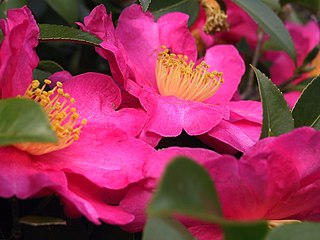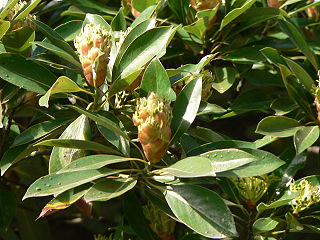
Mangifera is a genus of flowering plants in the cashew family, Anacardiaceae. It contains 64 species, with the best-known being the common mango. The center of diversity of the genus is in the Malesian ecoregion of Southeast Asia, particularly in Sumatra, Borneo, and the Malay Peninsula. They are generally canopy trees in lowland rainforests, reaching a height of 30–40 m (98–131 ft).

Camellia is a genus of flowering plants in the family Theaceae. They are found in tropical and subtropical areas in eastern and southern Asia, from the Himalayas east to Japan and Indonesia. There are more than 220 described species; almost all are found in southern China and Indochina. Camellias are popular ornamental, tea, and woody-oil plants cultivated worldwide for centuries. Over 26,000 cultivars, with more than 51,000 cultivar names, including synonyms, have been registered or published.

In the botanical classification of plants, Aeridinae Pfitzer is a subtribe of the tribe Vandeae whose representatives all have a monopodial growth habit and do not possess pseudobulbs.

Alpinia is a genus of flowering plants in the ginger family, Zingiberaceae. Species are native to Asia, Australia, and the Pacific Islands, where they occur in tropical and subtropical climates. Several species are cultivated as ornamental plants.

Theaceae, the tea family, is a family of flowering plants comprising shrubs and trees, including the economically important tea plant, and the ornamental camellias. It can be described as having from seven to 40 genera, depending on the source and the method of circumscription used. The family Ternstroemiaceae has been included within Theaceae; however, the APG III system of 2009 places it instead in Pentaphylacaceae. Most but not all species are native to China and East Asia.

Stewartia is a genus of 8-20 species of flowering plants in the family Theaceae, related to Camellia. Most of the species are native to eastern Asia in China, Japan, Korea, Laos, Myanmar, Thailand, and Vietnam, with two in southeast North America, from Virginia and Kentucky south to Florida and Louisiana.

Litsea is a genus of evergreen or deciduous trees or shrubs belonging to the laurel family, Lauraceae. The genus includes a large number of accepted species in tropical and subtropical areas of North America and Asia.

Machilus is a genus of flowering plants in the family Lauraceae. It is found in temperate, subtropical, and tropical forest, occurring in China, Korea, Japan, Taiwan, Indochina, the Indian subcontinent, Malaysia, Indonesia, and the Philippines. It is sometimes included in the genus Persea, and currently includes about 100 species.

Hydnocarpus is a genus of medium to large trees in the Family Achariaceae; the genus was previously placed in the now defunct family Flacourtiaceae. Species have been recorded from Indochina, Indonesia, Malaysia and the Philippines.

Actinodaphne is an Asian genus of flowering plants in the laurel family (Lauraceae). It contains approximately 125 species of dioecious evergreen trees and shrubs.

Adinandra is a genus of plant in the family Pentaphylacaceae. It contains the following species:

Schima is a genus of evergreen trees belonging to the tea family, Theaceae.

Ceriops is a genus of mangroves in family Rhizophoraceae.

Paraprenanthes is a genus of East Asian plants in the tribe Cichorieae within the family Asteraceae, most of the species found only in China.
The Teahouse is a 1974 Hong Kong crime drama directed by Kuei Chih-Hung. Written by On Szeto, the film is about an immigrant restaurant owner trying to protect his family from juvenile gangs. It was such a hit that the film was followed by a 1975 sequel, Big Brother Cheng, with kung fu star Chen Kuan Tai reprising the eponymous role.

Pyrenaria microcarpa is an evergreen plant in the family Theaceae. It is native from southern mainland China, east to Taiwan, and south to Myanmar and Vietnam.

Pyrenaria buisanensis is a species of tea endemic to Taiwan. It was first described by the Japanese botanist Shun-ichi Sasaki in 1931, but the herbarium specimens were lost and the species identity remained dubious until a 2004 publication that reported its rediscovery and reclassified it as a species of Pyrenaria. Its status remains controversial, with some sources including it in Pyrenaria microcarpa as P. microcarpa var. ovalifolia.

Polyspora is a genus of flowering plants in the tea family (Theaceae). It includes 47 species, which range from India through Indochina, southern China, Malesia, Taiwan and New Guinea.

















